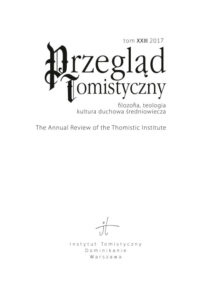MACIEJ ROSZKOWSKI OP, Christ’s Sacrifice – Atonement, Ransom or Glorification? Scheeben’s Interpretation of Christ’s Latreutic Sacrifice

Tom XXIII: 2017
Filozofia — Teologia— Kultura duchowa średniowiecza
ISSN 0860-0015
e-ISSN 2544-1000
SUMMARY
This article takes its point of departure from the work by Bernard Sesboüé, Jésus-Christ l’unique médiateur: essai sur la rédemption et le salut (1991), where one of the most recent systematizations and diagnoses of contemporary soteriological thought can be found. This paper discusses some of the crucial elements of Sesboüé’s analysis, then outlines the concept of Christ’s latreutic sacrifice, put forward by Matthias Joseph Scheeben in his book The Mysteries of Christianity (1865). Next, Scheeben’s concept is juxtaposed with Sesboüé’s systematization, in order to check how it would stand the latter’s critique and to what extent it fulfils Sesboüé’s requirements as to the new soteriology.
Scheeben’s essential argument concerns the latreutic nature of Christ’s sacrifice: Christ’s salvific deed should be understood as, on the one hand, a continuation of Trinitarian glorification and, on the other, as a perfection of the worship of God performed by the creation. The sacrifice seen as a glorification consists of two stages or moments: a moment of immolation, namely Christ’s passion and death, and moment of immutation, that is of resurrection and ascension through which Christ’s sacrifice becomes a pleasing odor to the Lord and a God’s possession.
The latreutic nature of Christ sacrifice is related to its internal dynamic: as it was offered in His physical body, so it should be offered in His Mystical Body, or in the Church. This latter offering has a sacramental nature, where the faithful are incorporated into Christ’s body and mission. In this way the sacrifice offered by the Church becomes the sacrifice of Christ Himself, and as Christ’s dignity is infinite and the offering is of immeasurable value, the homage thus paid to God exceeds any finite form of glorification.
The author of this paper is convinced that the concept put forward by Scheeben fulfils requirements outlined by Sesboüé to a large degree. This concept cannot be unequivocally classified as either the “ascending” model, or as the “descending” one, surpassing the dualism of two lines of soteriology and avoiding their one-sidedness. Moreover, accepting that Christ’s sacrifice is of a latreutic nature seems to guard soteriology against the many dangers and misuses that characterize approaches criticized by Sesboüé.
